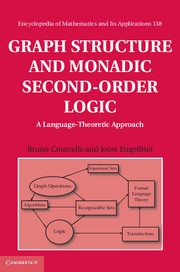Book contents
- Frontmatter
- Contents
- Foreword
- Introduction
- 1 Overview
- 2 Graph algebras and widths of graphs
- 3 Equational and recognizable sets in many-sorted algebras
- 4 Equational and recognizable sets of graphs
- 5 Monadic second-order logic
- 6 Algorithmic applications
- 7 Monadic second-order transductions
- 8 Transductions of terms and words
- 9 Relational structures
- Conclusion and open problems
- References
- Index of notation
- Index
Conclusion and open problems
Published online by Cambridge University Press: 05 July 2012
- Frontmatter
- Contents
- Foreword
- Introduction
- 1 Overview
- 2 Graph algebras and widths of graphs
- 3 Equational and recognizable sets in many-sorted algebras
- 4 Equational and recognizable sets of graphs
- 5 Monadic second-order logic
- 6 Algorithmic applications
- 7 Monadic second-order transductions
- 8 Transductions of terms and words
- 9 Relational structures
- Conclusion and open problems
- References
- Index of notation
- Index
Summary
We will leave it to the researchers of the next ten years and beyond to decide which of the results presented in this book are the most important. Here we will only indicate what are, in our opinion, the main open problems and research directions, among those that are closely related with the topics of this book.
Algorithmic applications
This topic, studied in Chapter 6, is the most difficult to discuss because of the large number of new articles published every year. Hence, the following comments have a good chance of becoming rapidly obsolete.
The algorithmic consequences of the Recognizability Theorem depend crucially on algorithms that construct graph decompositions of the relevant types or, equivalently, that construct terms over the signatures FHR, FVR which evaluate to the input graphs or relational structures. The efficiency of such algorithms, either for all graphs, but perhaps more promisingly for particular classes of graphs, is a bottleneck for applications.
Another difficulty is due to the sizes of the automata that result from the “compilation” of monadic second-order formulas. Their “cosmological” sizes (cf. [FriGro04], [StoMey], [Wey]) make their constructions intractable for general formulas. However, for certain formulas arising from concrete problems of hardware and software verification they remain manageable, as reported by Klarlund et al., who developed software for that purpose called MONA (cf. [Hen+], [BasKla]). Soguet [Sog] tried using MONA for graphs of bounded tree-width and clique-width, but even for basic graph properties such as connectivity or 3-colorability, the automata become too large to be constructed as soon as one wishes to handle graphs of clique-width more than 3.
Information
- Type
- Chapter
- Information
- Graph Structure and Monadic Second-Order LogicA Language-Theoretic Approach, pp. 686 - 690Publisher: Cambridge University PressPrint publication year: 2012
